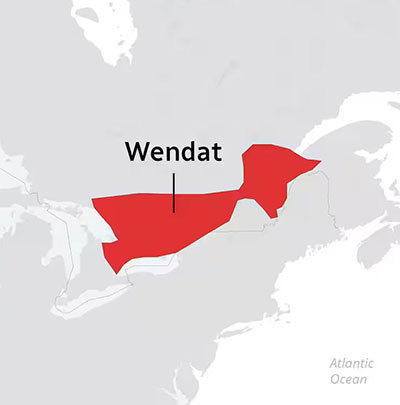The Wendat of the Ottawa Valley
 Until 1650, the lowest part of the Ottawa Valley was Wendat territory. They were an Iroquois-speaking agricultural people who felt more affinity with the up-river Algonquian peoples than to the Haudenosaunee south of the St.Lawrence River, and traded with furs along with them to French traders. It was those traders who derisively called them "Huron", an epithet closest in meaning to 'ruffian' in French of the time. In 1609, Samuel de Champlain solidified this division when he took the side of a Wendat-Algonquian group against a Mohawk war party.
This map produced by the CBC shows the Wendat territory then. It's unclear exactly how far up the river the Wendat territory extended, but the Chaudiere Falls would be a natural spot for the boundary. It is known to have been a sacred site for the Anishinabe.
Until 1650, the lowest part of the Ottawa Valley was Wendat territory. They were an Iroquois-speaking agricultural people who felt more affinity with the up-river Algonquian peoples than to the Haudenosaunee south of the St.Lawrence River, and traded with furs along with them to French traders. It was those traders who derisively called them "Huron", an epithet closest in meaning to 'ruffian' in French of the time. In 1609, Samuel de Champlain solidified this division when he took the side of a Wendat-Algonquian group against a Mohawk war party.
This map produced by the CBC shows the Wendat territory then. It's unclear exactly how far up the river the Wendat territory extended, but the Chaudiere Falls would be a natural spot for the boundary. It is known to have been a sacred site for the Anishinabe.
Between 1620-1640, European diseases, especially smallpox, against which our indigenous peoples had no immunity, killed at least 2/3 of all who had come in contact with Europeans. The 5 tribes of Wendat crashed from over 20,000 to about 9000; the Mohawk from 7740 to 2830. And so, in 1650 the Mohawk obtained guns from Dutch traders near New York, and headed up-valley to rebuild their population with Wendat. At least 3000 Wendat agreed to join the Mohawk; the rest either fled or were killed, along with all non-Iroquois-speaking people found in the area.
The lower Ottawa Valley was totally depopulated, so the Anishinabe (Algonquian people) moved into the vacuum. But the historical record is clear: the lower Valley was Wendat territory since time immemorial, not Anishinabe.
A personal note: Two young Wendat sisters survived the European diseases and were taken in by residents near today's Brébeuf. My eldest son is related by marriage to the descendants of one of them, and knows them well. The map at right was produced by the CBC for a program on them.
John Sankey
 Until 1650, the lowest part of the Ottawa Valley was Wendat territory. They were an Iroquois-speaking agricultural people who felt more affinity with the up-river Algonquian peoples than to the Haudenosaunee south of the St.Lawrence River, and traded with furs along with them to French traders. It was those traders who derisively called them "Huron", an epithet closest in meaning to 'ruffian' in French of the time. In 1609, Samuel de Champlain solidified this division when he took the side of a Wendat-Algonquian group against a Mohawk war party.
This map produced by the CBC shows the Wendat territory then. It's unclear exactly how far up the river the Wendat territory extended, but the Chaudiere Falls would be a natural spot for the boundary. It is known to have been a sacred site for the Anishinabe.
Until 1650, the lowest part of the Ottawa Valley was Wendat territory. They were an Iroquois-speaking agricultural people who felt more affinity with the up-river Algonquian peoples than to the Haudenosaunee south of the St.Lawrence River, and traded with furs along with them to French traders. It was those traders who derisively called them "Huron", an epithet closest in meaning to 'ruffian' in French of the time. In 1609, Samuel de Champlain solidified this division when he took the side of a Wendat-Algonquian group against a Mohawk war party.
This map produced by the CBC shows the Wendat territory then. It's unclear exactly how far up the river the Wendat territory extended, but the Chaudiere Falls would be a natural spot for the boundary. It is known to have been a sacred site for the Anishinabe.